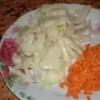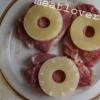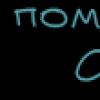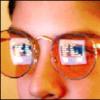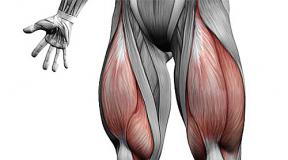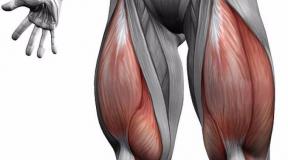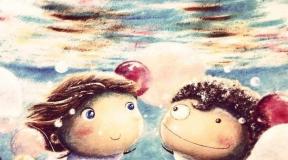Book: Jenkins Martin Discovering Space. From telescope to rover
If a child is interested in space, then this book is the next step in his knowledge. Even little techies like mine will be delighted with the technical details in the book. I have never seen more accurate and detailed drawings than Stephen Bisty's. He not only draws every detail on the ship's hull, but also every layer of its walls, partitions, skin - all that we will not see even in the photo.
I am wary of American authors, as I came across a book in which even Gagarin was not mentioned. Therefore, the first thing I paid attention to in the text was the honesty of the reflection of the history of space exploration. My thanks to the author - he tried to be objective. About the USSR-Russia, of course, little has been written, but still there is information.
The text is adapted for understanding by children (and mothers) - even a 5-year-old more or less understood everything. BUT! The peculiarity of the book is that the information is not superficial (this is a spacesuit, this is a rocket). The information is very detailed. Detailed to the explosion of the mother's brain. You will not find such details in any children's encyclopedia - this is the next step in the child's passion for space and technology.
The book gives a layered description of everything. If we read about the ship, then we learn about the components of its skin, where are the sensors and antennas, all the devices inside and outside.
My husband and I take turns reading. He really liked such detail in the information (he is a candidate of technical sciences). He later explained to me for a long time, with his usual calm enthusiasm, that the illustrations in the book are “good, drawn with engineering accuracy” - this is a high mark from him.
Just do not be afraid - the book is very interesting, it just gives a lot.
The disadvantage in it for me is the font - it is small and somehow thin. Only a schoolboy, perhaps, will read it on his own, although it is more likely for them and is designed for them, I'm always in a hurry.)))) The pages are printed on a good and rather dense chalk.
book in My shop , Ozone , labyrinth








Our shelf with space encyclopedias has replenished with one more magnificent space book. It was illustrated by the famous artist, the author of wonderful sections, Stephen Bisty. The book is replete with detailed drawings - three-dimensional diagrams of the structure of space stations, rockets, a scientific observatory, artificial satellites, rovers, space shuttles, buildings for vertical assembly of rockets, a spacesuit, and even an elevator of the future, stretching from the Earth to the Moon. All drawings contain explanations and captions explaining the device, composition, purpose of a particular part.
But along with beautiful illustrations, the book impresses with its content. We will learn:
- how Eratosthenes, Aristarchus of Samos, Ptolemy, Copernicus, Galileo Galilei and other scientists explained the structure of the universe in ancient times
- how people's knowledge has changed due to the invention of the telescope, how it works
- about human space exploration, about the race between the USSR and the USA for access to outer space, about our victories in this field, about the merits of the USA. Despite the fact that the book is translated, the role of the Soviet Union is in no way belittled.
- how the rocket is arranged, how it is launched and how the astronauts return to earth. It turns out that the Americans land their space stations in the ocean, while the Russian and Chinese ones land on land.
- about the work of the international space station: what is it for, what is inside, how astronauts eat, take a shower, sleep, why they need to train in space and how long a person can stay in outer space.
- about the exploration of other planets - what spacecraft allowed them to explore and what they found there. For example, it turns out that Venus is not at all suitable for life, its surface is hot up to 400 ˚ C, and the winds blow at a speed of 300 km / h.
But that's all! Thanks to the encyclopedia, you can go to the future, and, for example, see with your own eyes a laboratory on Mars and an elevator to space.
Magnificent in its informativeness, fascination and interestingness encyclopedia about space!
______________________________________________________
Martin Jenkins: Opening space. From telescope to rover
Illustrator: Steven Bisty
Publishing house Mann, Ivanov and Ferber, 2017
|labirint| http://www.labirint.ru/books/567342/
|my-shop| https://my-shop.ru/shop/books/2595335.html






Ekaterina Dneprovskaya, director, wrote a review of the book Discovering Space: From Telescope to Mars Rover.
Spaceships, robots and travel to distant planets are some of the favorite projects of today's children. The field of space robotics is actively developing, there is a place for many innovative inventions of rising engineers. For such enthusiastic children, the MIF publishing house has released a new book “Discovering space: from a telescope to a rover”, and the Edu-Craft robotics club is preparing a series of space events.
There are a huge number of books about space, but the new book from the MIF publishing house “Discovering Space from the Telescope to the Mars Rover” by Martin Jenkins can take its rightful place in the library of future space engineers. One of its main advantages is the illustrations by the British artist Stephen Bisty. According to him, he still does not use a computer, but makes each drawing with a pencil and ink, adding watercolors for color. In almost all of his illustrations, there is always a main character - a man. This is how the cold and unfriendly space came to life in this book.
In the book "Discovering Space" in the illustrations, you can see what the space suit consists of, in what compartments people are in the spacecraft and on the station, how the Mars station could look and function. But of greatest interest to us as roboticists is the image of the rover almost in section. Seeing what this research robot consists of by looking almost under its skin is a useful experience for every inventor, and using this illustration in robotics classes, you can push the guys to create really practice-oriented projects.
Despite the very detailed engineering illustrations, there is little factual material about space robotics in the book. Basically, these are facts from the history of research robots and what is happening to them now.
In general, Discovering Space from Telescope to Mars Rover will be a useful tool for teachers in cosmology classes and an exciting self-study of how everything works in space projects for each child.
About the book
For centuries, people have wondered, looking at the stars: "What is there, far, far away, in this black abyss?" The best minds of mankind tried to understand how our Universe works, what keeps the stars, the Sun, the Moon? At different times, the ancient Greek scientists Eratosthenes, Hipparchus, Aristarchus of Samos put forward their hypotheses - it was he who first suggested that it was not the Sun that revolves around the Earth, but vice versa. It was incredibly bold, because the Earth was then considered the center of the universe, around which the Sun, planets and stars revolve. The geocentric system of Ptolemy existed until the 16th century, until the Polish scientist Copernicus proposed his heliocentric model of the solar system, where everything revolves around the sun. The Copernican theory was proved thanks to one of the greatest discoveries - the invention of the telescope. The first model of the telescope was designed by the Italian mathematician Galileo Galilei, it gave a magnification of distant objects by 33 times. Observations of celestial bodies allowed ...
About the book
For centuries, people have wondered, looking at the stars: "What is there, far, far away, in this black abyss?" The best minds of mankind tried to understand how our Universe works, what keeps the stars, the Sun, the Moon? At different times, the ancient Greek scientists Eratosthenes, Hipparchus, Aristarchus of Samos put forward their hypotheses - it was he who first suggested that it was not the Sun that revolved around the Earth, but vice versa. It was incredibly bold, because the Earth was then considered the center of the universe, around which the Sun, planets and stars revolve. The geocentric system of Ptolemy existed until the 16th century, until the Polish scientist Copernicus proposed his heliocentric model of the solar system, where everything revolves around the sun. The Copernican theory was proved thanks to one of the greatest discoveries - the invention of the telescope. The first model of the telescope was designed by the Italian mathematician Galileo Galilei, it gave a magnification of distant objects by 33 times. Observations of celestial bodies allowed Galileo to conclude that Copernicus was right, and everything really revolves around the Sun. It was the appearance of the telescope that gave impetus to the study of space and since then people can no longer stop, and space is still full of secrets and mysteries.
In the middle of the 20th century, we moved from research to the conquest of space. In 1957, the first artificial earth satellite entered orbit. The space age of humanity has begun. And it is described in great detail in the book "Opening space. From the telescope to the rover." The captivating story is accompanied by illustrations by Stephen Bisty, a recognized master of wonderful sections. Thanks to his skill and deep knowledge, you will look at the Paranal Observatory on the top of the Chilean Andes, where the most advanced telescope to date is located - an interferometer. You will learn how the Soyuz rocket works - a real workhorse that delivers astronauts to the International Space Station. You will also visit the ISS itself - spend the whole day with the astronauts, see how they work, rest, eat, sleep, train. And you will also witness the space race between the USSR and the USA and find out who emerged victorious from it. And you can also try on an astronaut spacesuit. And this is not the whole list of amazing discoveries that await you on the pages of this wonderful book.
book chips
Acquaintance with all existing spacecraft: space rockets and shuttles, probes, satellites, telescopes
The whole journey of man into space
Review of the most important technical achievements and technological breakthroughs in the conquest of space
Space elevator, house on Mars - dreams or reality? The answer is in the book.
Who is this book for?
This book is for little astronauts and already adult astronomers, and for everyone who has ever looked enchanted at the starry sky and wanted to know these secrets of our world that have become a little closer.
About authors
Martin Jenkins is an English biologist who wrote many famous children's books, including The Emperor's Egg illustrated by Jane Chapman and Can We Save the Tiger? illustrated by Vicki White.
Stephen Bisty is a legendary illustrator and bestselling author of Miraculous Sections. Each of his new books is an event for readers. So it was with the Great Buildings. Since its release, the book has been Amazon.com's best-selling children's architecture book.
Stephen Bisty was born and raised in the UK and has always been interested in art and historical reenactments. His legendary book "Wonderful Sections" became a worldwide bestseller and gave millions of children the opportunity to look inside the buildings, ships and mechanisms of all time. He creates all his illustrations using paper, ink and paints, and never uses rulers, all drawings are only by hand!
Steven says: "Actually, the details in an illustration are endless. I've never used a computer and don't think I'll ever start. I use pencil and ink, and to add color and texture to an image, I use watercolors. I also always try to add people in the image, as an illustrator, I noticed that it is the figures of people that attract the eye and the drawing comes to life.
For middle school age.
For centuries, people have wondered, looking at the stars: “What is there, far, far away, in this black abyss?” The best minds of mankind tried to understand how our Universe works, what keeps the stars, the Sun, the Moon? At different times, the ancient Greek scientists Eratosthenes, Hipparchus, Aristarchus of Samos put forward their hypotheses - it was he who first suggested that it was not the Sun that revolved around the Earth, but vice versa. It was incredibly bold, because the Earth was then considered the center of the universe, around which the Sun, planets and stars revolve. The geocentric system of Ptolemy existed until the 16th century, until the Polish scientist Copernicus proposed his heliocentric model of the solar system, where everything revolves around the sun. The Copernican theory was proved thanks to one of the greatest discoveries - the invention of the telescope. The first model of the telescope was designed by the Italian mathematician Galileo Galilei, it gave a magnification of distant objects by 33 times. Observations of celestial bodies allowed Galileo to conclude that Copernicus was right, and everything really revolves around the Sun. It was the appearance of the telescope that gave impetus to the study of space and since then people can no longer stop, and space is still full of secrets and mysteries.
In the middle of the 20th century, we moved from research to the conquest of space. In 1957, the first artificial earth satellite entered orbit. The space age of humanity has begun. And it is described in great detail in the book “Opening Space. From telescope to rover. The captivating story is accompanied by illustrations by Stephen Bisty, a recognized master of wonderful sections. Thanks to his skill and deep knowledge, you will look at the Paranal Observatory on the top of the Chilean Andes, where the most advanced telescope to date is located - the interferometer. You will learn how the Soyuz rocket works - a real workhorse that delivers astronauts to the International Space Station. You will also visit the ISS itself - spend the whole day with the astronauts, see how they work, rest, eat, sleep, train. And you will also witness the space race between the USSR and the USA and find out who emerged victorious from it. And you can also try on an astronaut spacesuit. And this is not the whole list of amazing discoveries that await you on the pages of this wonderful book.
book chips
- Acquaintance with all existing spacecraft: space rockets and shuttles, probes, satellites, telescopes
- The whole journey of man into space
- Review of the most important technical achievements and technological breakthroughs in the conquest of space
- A space elevator, a house on Mars - dreams or reality? The answer is in the book.
Who is this book for?
This book is for little astronauts and already adult astronomers, and for everyone who has ever looked enchanted at the starry sky and wanted to know these secrets of our world that have become a little closer.
Expand description Collapse Description



